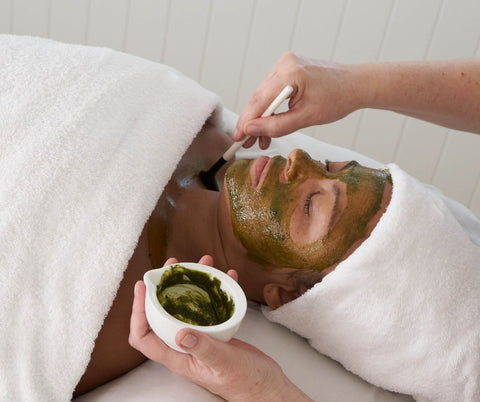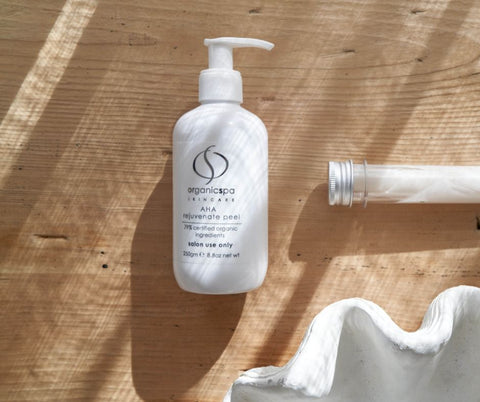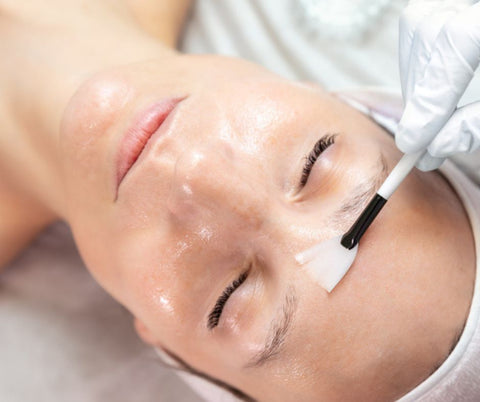Not all peels are equal
You might not have thought about this before but fruit acids, enzymes and chemicals have been used in beauty products for centuries. Perhaps the most recognised demonstration of this is Cleopatra’s ritual of bathing in milk to lighten and soften her skin. It is after-all the Lactic Acid found in dairy milk that offers these benefits. Additionally, the Ancient Greeks used yogurt for the same reason (AHAs), the Romans bathed in wine for the Tartaric Acid benefits, the Japanese used Rice Extract to help soften and lighten their skin.
Despite wide use spanning many cultures throughout history, peels actually didn’t become mainstream in beauty salons until the 1970s.

Different types of peels
Fruit Acids
These are naturally occurring in sugarcane, sugar beet, citrus fruit, garlic, onions, grapes, willow bark, nuts, rice and more. They are widely used in skincare for their exfoliating properties, collagen stimulating ability, pigmentation reduction and brightening properties, and their contribution to a softer and more hydrated skin.
Fruit Acids work by dissolving the glue that bonds the dead skin cells together, this in turn, helps promote new cell turnover which stimulates collagen production. This will also help with brightening the surface of the skin. Additionally they act as humectants - meaning they attract and hold hydration in the skin.
Let’s explore the different types;
AHA – alpha hydroxy acid
The most used in skincare and beauty treatments of all fruit acids. AHA’s are water soluble. AHAs come from many different sources;
- Glycolic Acid: Derived from sugarcane, garlic, onions and beet. It is one of the smallest of the AHA molecules which gives it the ability to work deeper to exfoliate dead skin cells and to help stimulate new cell turnover.
- Lactic Acid: Found in milk and, to the delight of vegan friendly brands such as organicspa, it also comes from fermented vegetables and fruits. This particular AHA has the ability to brighten and fade dark spots, soften fine lines and offers general exfoliation. It also is the most hydrating of all the Fruit Acids.
- Citric Acid: Unsurprisingly, derived from citrus fruits, it’s best for brightening and fading dark spots and has great antibacterial and antioxidant properties.
- Malic: Derived from apples and other fruit, is a mild exfoliant that also helps brighten and soften the complexion.
- Mandelic: Derived from almonds. This will be helpful in combating oil production and is antibacterial. Like all fruit acids it will help improve the texture and brighten the complexion, but because of these added benefits it is great for an acne prone skin.

BHA - Beta Hydroxy Acids
BHAs also act as an exfoliant. BHAs are typically gentler than AHAs (that can cause occasional irritation). They are oil soluble and have a much smaller molecule than their AHA sister.
BHAs can be found in the following;
-
Salicylic Acid – most commonly used in skincare today, usually derived from aspirin.
-
Willow Bark Extract – (Salicin) used as far back as the 17th Century to soothe irritated skin. It is lipid soluble and derived from the willow tree. Both anti-inflammatory and antibacterial, Willow Bark helps to clear the pores and alleviate acne and irritation. Salicin’s anti-inflammatory effects have shown to assist with wrinkles, and even out skin tone.
-
Winter Green – is a small shrub collected for the leaves rich in essential oil composed of Methyl Salicylate. A natural Beta Hydroxy Acid, Winter Green OIl enhances cell turnover, is safe, non-irritating and non-photosensitizing and has anti-microbial capabilities.
At organicspa, we choose to use either Willow Bark or Winter Green Extract to naturally resurface the skin.
Fruit Enzymes
Fruit Enzymes are proteolytic enzymes and in contrast to Fruit Acids which dissolve the ‘glue’ of your outer skin layer, they help exfoliate by breaking down the keratin protein as part of the outer layers of your skin.
The most common Fruit Enzymes used in skincare are; pineapple, papaya, kiwi fruit and mango. An extremely gentle alternative to Fruit Acids, they are especially beneficial for those with sensitive skin or during pregnancy.
Chemical peels

These peels affect the epidermis (top layer) of skin and sometimes the dermis, which contains nerve endings, sweat glands, hair follicles and fibroblasts. This exfoliation process happens by changing the skin’s pH levels. As the pH changes from around 5.5 to approximately 2.8 the peel causes trauma (a wound). It then promotes the growth of new skin cells (to repair the damaged tissue) by sending messages to activate the fribroblast to kick-start collagen production.
A commonly used chemical peel is TCA, otherwise known as Trichloroacetic Acid, a derivative from vinegar. Used in concentrations of 15–70%. After a TCA peel, your skin will usually appear red and feel swollen for several days, transitioning into darkening, crusting, and peeling of the treated area in layers. This can be painful. These peels should be used with caution and sparingly for skin conditions prone to scaring and severe pigmentation.
Following a chemical peel, some complexions can develop a temporary or permanent discolouration. If you are taking the contraceptive pill, pregnant, or have a family history of brownish discolouration on the face this may be more likely. There is also a risk of scarring.
Keep in mind too that while the skin rapidly works to repair the damage, this repair tissue does not gain the strength of the previous skin layers. At best it will return to 80% tensile strength (meaning its ability to withstand tension before it tears or is subsequently damaged). This skin weakening will have significant impact on the skin’s longterm integrity.
Choosing the correct peel
At organicspa we take a gentle approach to our professional peels. We carefully combine a balanced, effective combination of all AHAs, BHAs and Fruit Enzymes to achieve the optimum result, without compromising the integrity of the skin or sensitising it in any way.

Our AHA rejuvenate peel will provide intense support for cellular regeneration. Used as a standalone treatment or supplementary to an organicspa signature facial, this formulation combines 11% AHA, 1% BHA and 1% Enzymes with Aloe Vera and Olive Leaf Extract to soothe and calm the skin - offering a gentle, yet potent, exfoliation. This bio-active peel is suitable for most skin types to help improve elasticity and refine and rejuvenate the skin without the use of synthetic ingredients.
For more intensive (yet not aggressive) results we have our lactic enzyme - renew & resurface treatment. The Lactic+ enzyme compound combines 20% lactic powder, 11% AHA, 1% BHA with 6% enzymes to help increase cell turnover, smooth and resurface the skin while improving hydration levels.
Opt for an organic professional exfoliation

In conversation with organicspa advocate and skin expert, Belinda Hughs, recently she shared her thoughts on chemical vs organic approach to peels. This is what she had to say;
“When we talk about organic peels as opposed to chemical peels we almost have to give them a different name. An organic 'peel' is not going to take off layers of skin, and create an injury for your skin to heal from. Organic peels are more like a deeper professional exfoliation, which keeps the skin intact and healthy, removing the dead layers without causing harm to the skin. This is a much more sustainable treatment for your skin, which gives skin a beautiful glow and the results clients are looking for. If you're looking for healthy, glowing long-term results I would also opt for an organic professional exfoliation over a 'chemical peel'. ~ Belinda Hughes – The Natural Beauty Expert
When it comes to skincare at organicspa we opt for natural, Certified Organic, formulas that do you compromise healthy, living skin cells like chemical alterntives. A more gentle, and sustainable approach to healthy skin. Find one of our skin specialists near you to experience an organic exfoliation treatment.

